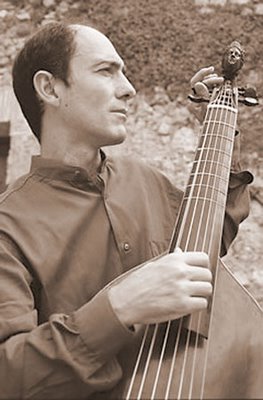Angel and Devil: Paolo Pandolfo at Dumbarton Oaks
Pour nos lecteurs francophones, j'ai préparé une traduction française de ce compte rendu. Veuillez m'en excuser les fautes de grammaire et d'orthographe.
Musica Alta Ripa at Dumbarton Oaks (May 10, 2005) Dumbarton Oaks (May 9, 2005) |
 Paolo Pandolfo played with the premiere gamba player of our time, Jordi Savall, in his group Hesperion XXI. He has since struck off onto a solo career of his own and teaches and leads his own group. Prior to his work with Savall, at the Schola Cantorum Basiliensis (Basel, Switzerland), Pandolfo studied with Enrico Gatti and Rinaldo Alessandrini, and he has worked on recordings with Savall, Alessandrini, and Fabio Biondi. It's quite a résumé, and his playing on Saturday night certainly made clear why he has had those opportunities, as he took us on a tour through the music of three giants of French viol music.
Paolo Pandolfo played with the premiere gamba player of our time, Jordi Savall, in his group Hesperion XXI. He has since struck off onto a solo career of his own and teaches and leads his own group. Prior to his work with Savall, at the Schola Cantorum Basiliensis (Basel, Switzerland), Pandolfo studied with Enrico Gatti and Rinaldo Alessandrini, and he has worked on recordings with Savall, Alessandrini, and Fabio Biondi. It's quite a résumé, and his playing on Saturday night certainly made clear why he has had those opportunities, as he took us on a tour through the music of three giants of French viol music.The art of the French viol, or viola da gamba, was more or less invented by a great master in the second half of the 17th century, Monsieur de Sainte-Colombe. His skill was matched only by his secrecy, for he guarded his works and techniques jealously. As shown with moderate historical accuracy in the excellent film Tous les matins du monde, a young player named Marin Marais had to be as shrewd as Ulysses to learn the art from his severe teacher, going so far as hiding in Sainte-Colombe's studio to watch him practice. Pandolfo's first half combined the works of both student and teacher.
| Available at Amazon: J. S. Bach, Six Suites for Unaccompanied Cello, arranged for viola da gamba, Paolo Pandolfo |
Pandolfo was joined on all but the prelude movement by Thomas C. Boysen on either Baroque guitar or theorbo and a young harpsichordist from France, Marie Gelis. Both made excellent supporting contributions, although Pandolfo was the lead voice of this ensemble. In that role, he gave a humorous introduction to the two famous pieces by Marin Marais, beginning with La Labyrinthe, a program suite that depicts a naive A major melody lost in a maze of foreign keys. The group that Pandolfo now leads, Labyrinto, takes its name, I believe, from this work. It is a consummately Baroque piece -- dramatic, witty, sparkling, ever-changing, permeated by dance -- and obviously dear to Pandolfo's heart. Accompanied by theorbo and harpsichord, Pandolfo's lost melody soared in exultation, whined and shivered in despair, questioned, answered, wandered. This performance was a superlative example of the expressive, almost vocal power of the viol's sound. At the end, we were overjoyed to follow that poor melody up its little glissando ladder back into A major. The concluding chaconne, an enigmatic bass pattern other than the traditional descending minor tetrachord, was a marvel. Marais's musical tribute to his departed teacher, the Tombeau de Mr. de Sainte-Colombe, in which we can hear snatches of the master's works, was a fitting end to the first half.
Thomas Boysen gave us two works for theorbo to open the second half, a Prelude and Chaconne en rondeau by Robert de Visée, the guitar teacher and personal lutenist of Louis XIV (or as Boysen said charmingly in his accented English, "Ludwig XIV"). This composer's job was to follow the King of France throughout his day, walking behind him or sitting near him, playing to divert the royal ear. Boysen introduced de Visée as "the world's first walkman," a quip that got a lot of laughs. This chaconne was the third of four such pieces on the program. While interesting and very well performed, its inferiority in the company of the masters of the viol revealed that the demands of de Visée's position were probably acceptable only to a composer of lesser talent.
Antoine Forqueray, Pièces de Viole avec la Basse, Book 1, Suites 1-5, Paolo Pandolfo, with Guido Balestracci, Eduardo Eguez, Rolf Lislevand |
For Paolo Pandolfo's other recordings, including some of the pieces reviewed here, you have to contact the recording company, Glossa, directly. I would very much like to hear all of them.





















































No comments:
Post a Comment